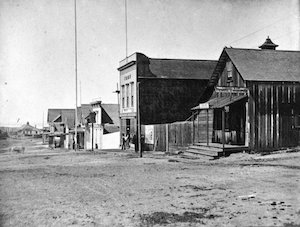
A view of buildings along west Main Street in Mendocino, looking westward between 1874 and 1878. The photograph would have been taken four to eight years after the devastating fire of 1870, which destroyed all the buildings that originally stood on this block.
On the right is the Chinese laundry, with a sign over the front porch that reads, “Chung Kow Washing and Ironing.” A set of wooden steps descends to the unpaved street. It remained at this location on the northwest corner of Kasten and Main Streets until 1906, when it was torn down to make way for the bank building. Other buildings occupied by the sizable Chinese population in Mendocino were found across the street and in other locations around town.
Proceeding westward down the street, an unpainted board fence with a poster or sign attached to its front encloses the space between the wash house and the two-story Murray Building. J. D. Murray’s Drugstore occupied the first floor. A sign in the shape of a large mortar and pestle sits on a pole by the boardwalk out front. The second floor was used as a hall for public events, meetings, and performances, and also by the Independent Order of Odd Fellows (note the I.O.O.F. sign on the building’s second level) when they first organized in Mendocino. The group moved into their own hall up Kasten Street in 1879.
Next, another gap in the line of buildings, enclosed with a white board fence, will be filled in 1878 by Eugene Brown’s house. Constructed about 25 feet back from the street, it isn’t visible in this view. However, it appears as if scaffolding is on site, seen leaning out from the corner of the drugstore building, so the house may already be under construction.
Adjacent to the site of Eugene Brown’s house is his one-story general merchandise store. It has a short false front constructed against the gable of the low-pitched roof seen behind it.
The next building is two-stories and set back from the street a short distance. A canopy extends over the boardwalk. A tall false front topped by a large cornice casts a shadow on the roof behind it (seen in this image beyond the drugstore sign).
To the left of that is the Everson Store with its small dormer window facing the camera. At this time, the store accommodated the office of the Western Union Telegraph Co. This is the only building in this view that is still standing on its original spot in 2021 – all the others have burned, been demolished, or have been significantly changed.
The next buildings, which are difficult to distinguish in the photograph, house saloons and lodging places, including the large City Hotel at the end. The building with the hip roof and central chimney located out from the line of other structures where Heeser Drive turns north at the end of Main Street, was the Mendocino Lumber Company’s cookhouse. Beyond it, high stacks of lumber can be seen waiting in the yard for loading onto moored ships at the Shipping Point.
In this photograph there are four flagpoles – referred to as “Liberty Poles” in the nineteenth century. One is attached to the front façade of the Murray Building, another stands on the street near Brown’s store, and two more can be seen farther down at Manuel Thomas’ hotel and saloon, and then in front of the City Hotel at the end. In its early years, Mendocino was known not only for its many water towers but also for its numerous flagpoles – some were over 100 feet high.
The date range of this photo is based on the presence of Eugene Brown’s store (built in 1874) and the IOOF sign still on the Murray Building. (Gift of Emery Escola, Emery Escola Collection, Kelley House Photographs)
The Kelley House relies on the generous support of its community, which has helped us get through this difficult year. Donations of any amount are always welcome.